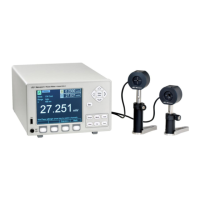118 Principles of Operation
The analog signal flow path is primarily determined by the responsivity units
of the detector. The numerator of these units indicates how the meter must be
configured in order to obtain a calibrated optical measurement. Analog signal
flow is independent of whether single or continuous measurements are made.
Responsivity units and signal flows for the various detector families are listed
in Table 4.
Table 4 Analog Signal Flow Paths.
9.3 Digitized Signal Flow
An analog-to-digital converter captures the input signal. The input signal has
the units of current or voltage depending upon how the input amplifier chain
was configured. Note: In this manual the digitized signal may be referred as
sampled signal or samples.
This digitized signal moves through a number of process steps that may or
may not alter the digitized value depending upon the operating state of the
meter. Each of these possible-processing steps is discussed further.
Digital Filter
If the digital filter annunciator Dig or Digital is on, Section 2.3.4, the filter
output is the average of the most recent 10, 100, 1000, 10000 samples. The
number of samples is selectable by the user with the Filter menu. Also, The
user can change the number of samples. When less than the selected number
of samples has been acquired since the last reset of the digital filter, the
output is the average of all the values received. The digital filter is reset when
the Model 1936/2936 is turned on and whenever the UNITS or the range
changes or when the MODE of operation changes.
NOTE
When using the digital filter in CW Single acquisition mode, each measurement is
the average of the last 10, 100, 1000, 10000 acquisitions independent of how old
any of the measurements are.
Gain
Gain processing accounts for the signal gain of the input amplifiers. The
output is the product of the digitized value and the amplifier gain.

